A Metamaterial-Based Compact Planar Monopole Antenna for Wi-Fi and UWB Applications
Abstract
:1. Introduction
2. Antenna Design and Methodology
2.1. Antenna Geometry
2.2. Composite Right Left Hand (CRLH) Metamaterial (MTM) Theory
2.3. Antenna Parametric Study
3. Experimental Results and Discussions
3.1. Radiation Characteristics
3.2. Comparison with Other Reported Designs
4. Conclusions
Author Contributions
Funding
Conflicts of Interest
References
- Cheng, G. Accurate TOA-based UWB localization system in coal mine based on WSN. Phys. Procedia 2012, 24, 534–540. [Google Scholar] [CrossRef] [Green Version]
- Bharadwaj, R.; Swaisaenyakorn, S.; Parini, C.G.; Batchelor, J.; Alomainy, A. Localization of wearable ultrawideband antennas for motion capture applications. IEEE Antennas Wirel. Propag. Lett. 2014, 13, 507–510. [Google Scholar] [CrossRef] [Green Version]
- Commission, F. Revision of Part 15 of the Commission’s Rules Regarding Ultra-Wideband Transmission Systems; First Report and Order; Federal Communications Commission: Washington, DC, USA, 2010. [Google Scholar]
- Xu, H.; Yang, L. Ultra-wideband technology: Yesterday, today, and tomorrow. In Proceedings of the IEEE Radio and Wireless Symposium, Orlando, FL, USA, 22–24 January 2008; pp. 715–718. [Google Scholar]
- Mayer, P.; Magno, M.; Schnetzler, C.; Benini, L. EmbedUWB: Low Power Embedded High-Precision and Low Latency UWB Localization. In Proceedings of the 2019 IEEE 5th World Forum on Internet of Things (WF-IoT), Limerick, Ireland, 15–18 April 2019; IEEE: Piscataway, NJ, USA, 2019. [Google Scholar]
- Mirza, A.F.; See, C.H.; Danjuma, I.M.; Asif, R.; Abd-Alhameed, R.A.; Noras, J.M.; Clarke, R.W.; Excell, P.S. An active microwave sensor for near field imaging. IEEE Sens. J. 2017, 17, 2749–2757. [Google Scholar] [CrossRef]
- Silva, B.; Hancke, G.P. IR-UWB-based non-line-of-sight identification in harsh environments: Principles and challenges. IEEE Trans. Ind. Inform. 2016, 12, 1188–1195. [Google Scholar] [CrossRef]
- Li, Q.; Xiao, X.; Song, H.; Wang, L.; Kikkawa, T. Tumor response extraction based on ensemble empirical mode decomposition for early breast cancer detection by UWB. In Proceedings of the 2014 IEEE Biomedical Circuits and Systems Conference (BioCAS) Proceedings, Lausanne, Switzerland, 22–24 October 2014; IEEE: Piscataway, NJ, USA, 2014. [Google Scholar]
- Dawar, P.; Raghava, N.; De, A. UWB Metamaterial-Loaded Antenna for C-Band Applications. Int. J. Antennas Propag. 2019, 2019, 13. [Google Scholar] [CrossRef]
- Alnaiemy, Y.; Lajos, N. Design and analysis of Ultra-Wide Band (UWB) antennas based on metamaterial. In Proceedings of the 2018 11th International Symposium on Communication Systems, Networks & Digital Signal Processing (CSNDSP), Budapest, Hungary, 18–20 July 2018; IEEE: Piscataway, NJ, USA, 2018. [Google Scholar]
- Dawar, P.; De, A.; Raghava, N. S-shaped metamaterial ultra-wideband directive patch antenna. Radioelectron. Commun. Syst. 2018, 61, 394–405. [Google Scholar] [CrossRef]
- Patir, D.; Dipak, K.N. A Uwb Metamaterial Based Patch Antenna For Band Notching And Mimo Application. Int. J. Eng. Sci. Invent. 2018, 7, 53–58. [Google Scholar]
- Alhawari, A.R.; Ismail, A.; Mahdi, M.A.; Abdullah, R.S. Miniaturized ultra-wideband antenna using microstrip negative index metamaterial. Electromagnetics 2011, 31, 404–418. [Google Scholar] [CrossRef]
- Wang, F.; Duan, Z.; Tang, T.; Huang, M.; Wang, Z.; Gong, Y. A new metamaterial-based UWB MIMO antenna. In Proceedings of the 2015 IEEE International Wireless Symposium (IWS 2015), Shenzhen, China, 30 March–1 April 2015; IEEE: Piscataway, NJ, USA, 2015. [Google Scholar]
- Jaglan, N.; Gupta, S.D.; Kanaujia, B.K.; Srivastava, S.; Thakur, E. Triple band notched Dg-Cebg structure based Uwb MIMO/diversity antenna. Prog. Electromagn. Res. 2018, 80, 21–37. [Google Scholar] [CrossRef] [Green Version]
- Dai, Y.L.; Yuan, B.; Zhang, X.H.; Dai, X.W.; Luo, G.Q. A novel compact ultra-wideband metamaterial-based microstrip antenna. In Proceedings of the 2016 IEEE MTT-S International Microwave Workshop Series on Advanced Materials and Processes for RF and THz Applications (IMWS-AMP), Chengdu, China, 20–22 July 2016; IEEE: Piscataway, NJ, USA, 2016. [Google Scholar]
- Roy, B.; Chowdhury, S.K.; Bhattacharjee, A.K. Symmetrical Hexagonal Monopole Antenna with Bandwidth Enhancement under UWB Operations. In Wireless Personal Communications; Springer: Berlin/Heidelberg, Germany, 2019; pp. 1–11. [Google Scholar]
- Ghattas, A.S.W.; Khaled, E.E.M. A compact proximity-fed ultra-wide band patch antenna with four notched-band characteristics: Design and implementation. In Proceedings of the 2014 9th International Symposium on Communication Systems, Networks & Digital Sign (CSNDSP), Manchester, UK, 23–25 July 2014; IEEE: Piscataway, NJ, USA, 2014. [Google Scholar]
- Hammad, Y.T.; Fouda, Z.K.; Abdalla, M.A. An ultra wide band filter with high selective dual notching. In Proceedings of the 2017 IEEE International Symposium on Antennas and Propagation & USNC/URSI National Radio Science Meeting, San Diego, CA, USA, 9–14 July 2017; IEEE: Piscataway, NJ, USA, 2017. [Google Scholar]
- Stefaia, M.; Bergenti, F. Hybride Indoor Localization using WiFi and UWB Technologies. Electronics 2019, 8, 334. [Google Scholar]
- Kołodziej, J.; Grzonka, D.; Widłak, A.; Kisielewicz, P. Ultra Wide Band Body Area Networks: Design and Integration with Computational Clouds. In High-Performance Modelling and Simulation for Big Data Applications; Springer: Berlin/Heidelberg, Germany, 2019; pp. 279–306. [Google Scholar]
- Mandal, T.; Das, S. Design of a microstrip fed printed monopole antenna for bluetooth and UWB applications with WLAN notch band characteristics. Int. J. RF Microw. Comput. Aided Eng. 2015, 25, 66–74. [Google Scholar] [CrossRef]
- Mishra, S.K.; Gupta, R.K.; Vaidya, A.; Mukherjee, J. A compact dual-band fork-shaped monopole antenna for Bluetooth and UWB applications. IEEE Antennas Wirel. Propag. Lett. 2011, 10, 627–630. [Google Scholar] [CrossRef]
- Taheri, M.S.; Mallahzadeh, A.R.; Nezhad, S.M.; Ghasemi, A.H. A compact triple-band fork-shaped printed slot antenna for GSM, Bluetooth and UWB applications. In Proceedings of the 2012 6th European Conference on Antennas and Propagation (EUCAP), Prague, Czech Republic, 26–30 March 2012; IEEE: Piscataway, NJ, USA, 2012. [Google Scholar]
- Cai, L.Y.; Zeng, G.; Yang, H.C.; Cai, Y.Z. Integrated Bluetooth and multi-band ultra-wideband antenna. Electron. Lett. 2011, 47, 688–689. [Google Scholar] [CrossRef]
- Rahman, M.; NagshvarianJahromi, M.; Mirjavadi, S.S.; Hamouda, A.M. Compact UWB Band-Notched Antenna with Integrated Bluetooth for Personal Wireless Communication and UWB Applications. Electronics 2019, 8, 158. [Google Scholar] [CrossRef] [Green Version]
- Yildirim, B.S.; Cetiner, B.A.; Roqueta, G.; Jofre, L. Integrated bluetooth and UWB antenna. IEEE Antennas Wirel. Propag. Lett. 2009, 8, 149–152. [Google Scholar] [CrossRef]
- Yildirim, B.S. Low-profile and planar antenna suitable for WLAN/Bluetooth and UWB applications. IEEE Antennas Wirel. Propag. Lett. 2006, 5, 438–441. [Google Scholar] [CrossRef]
- Bae, J.H.; Jeong, J.G.; Yoon, Y.J.; Kim, Y. A compact monopole antenna for bluetooth and UWB applications. In Proceedings of the 2017 International Symposium on Antennas and Propagation (ISAP), Phuket, Thailand, 30 October–2 November 2017; IEEE: Piscataway, NJ, USA, 2017. [Google Scholar]
- Lai, A.; Itoh, T.; Caloz, C. Composite right/left-handed transmission line metamaterials. IEEE Microw. Mag. 2004, 5, 34–50. [Google Scholar] [CrossRef]
- Liu, C.; Menzel, W. On the relation between composite right-/left-handed transmission lines and chebyshev filters. Int. J. Microw. Sci. Technol. 2009, 2009, 8. [Google Scholar] [CrossRef] [Green Version]
- Li, Z.; Ruan, C.; Peng, L. Design and analysis of planar antenna with dual WLAN band-notched for integrated bluetooth and UWB applications. J. Electromagn. Waves Appl. 2010, 24, 1817–1828. [Google Scholar]
- Zhan, K.; Guo, Q.; Huang, K. A miniature planar antenna for Bluetooth and UWB applications. J. Electromagn. Waves Appl. 2010, 24, 2299–2308. [Google Scholar] [CrossRef]

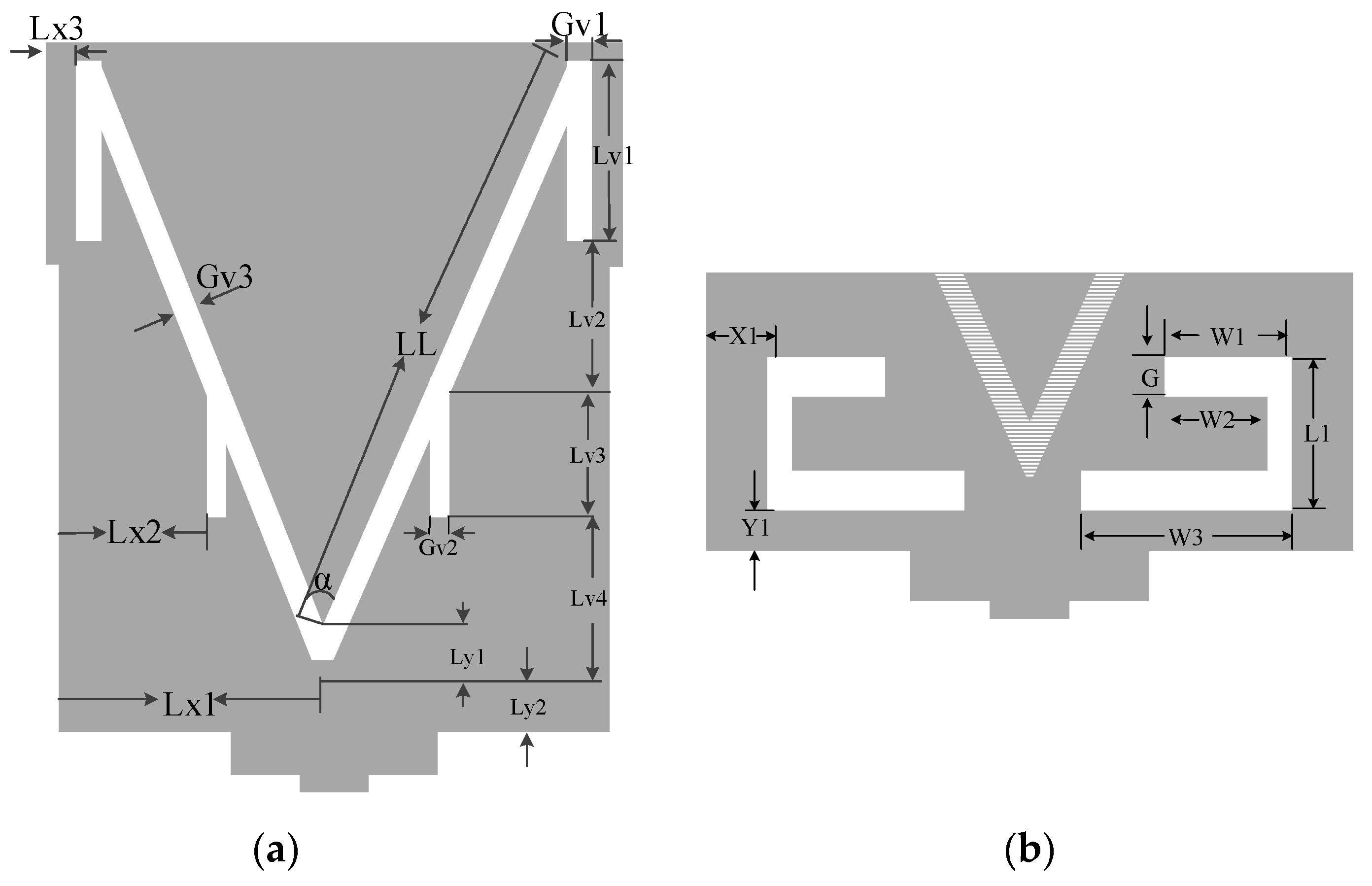


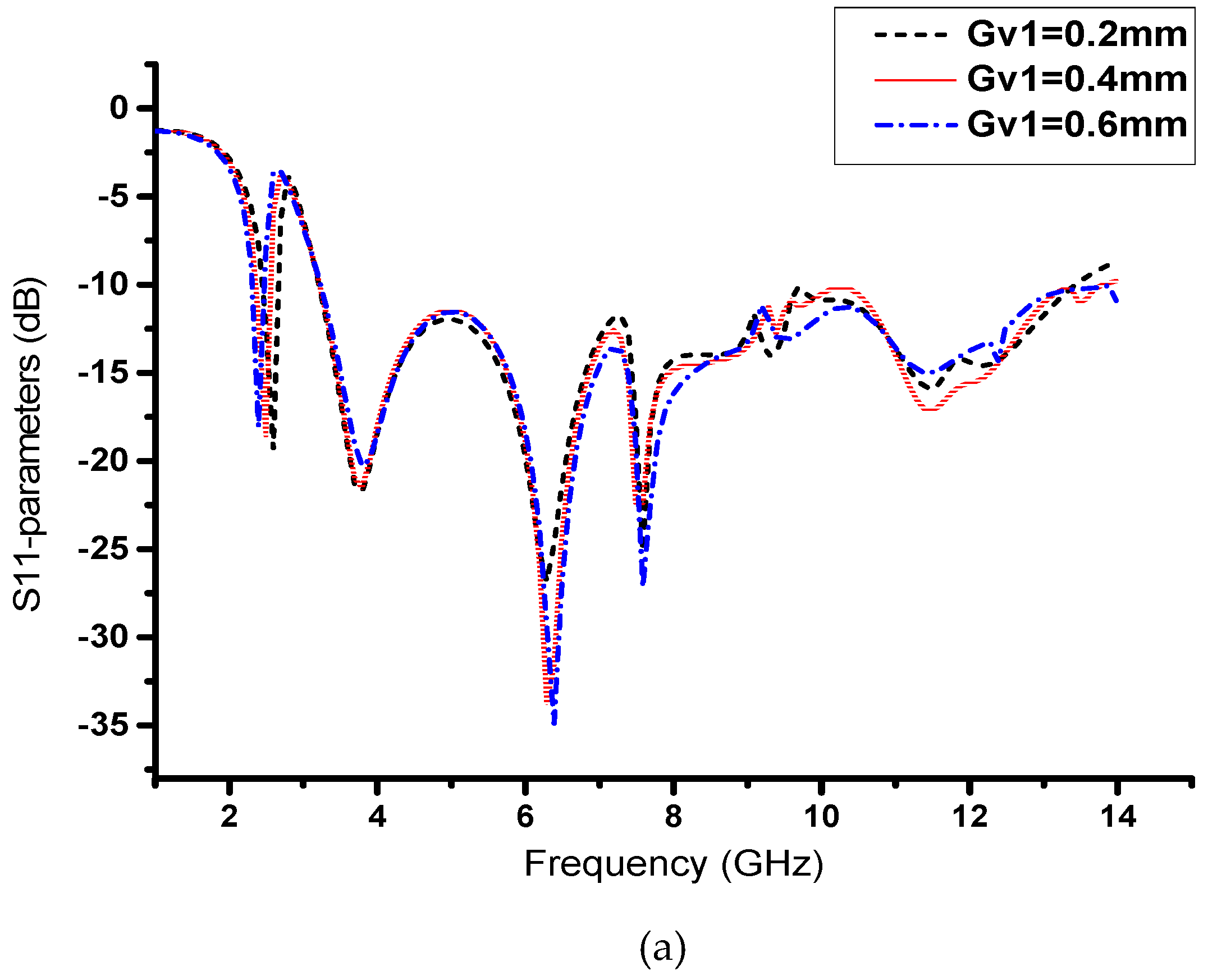

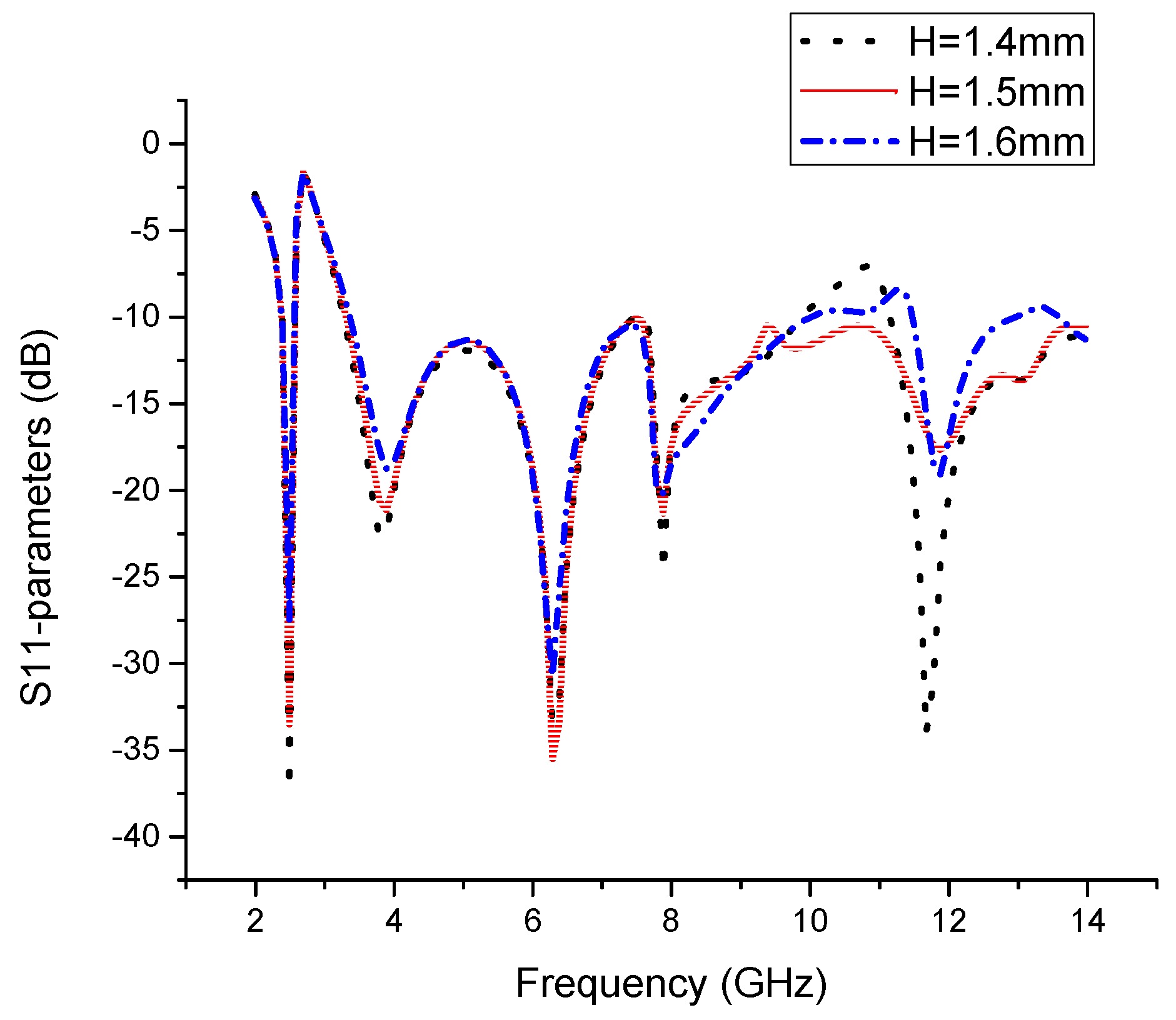
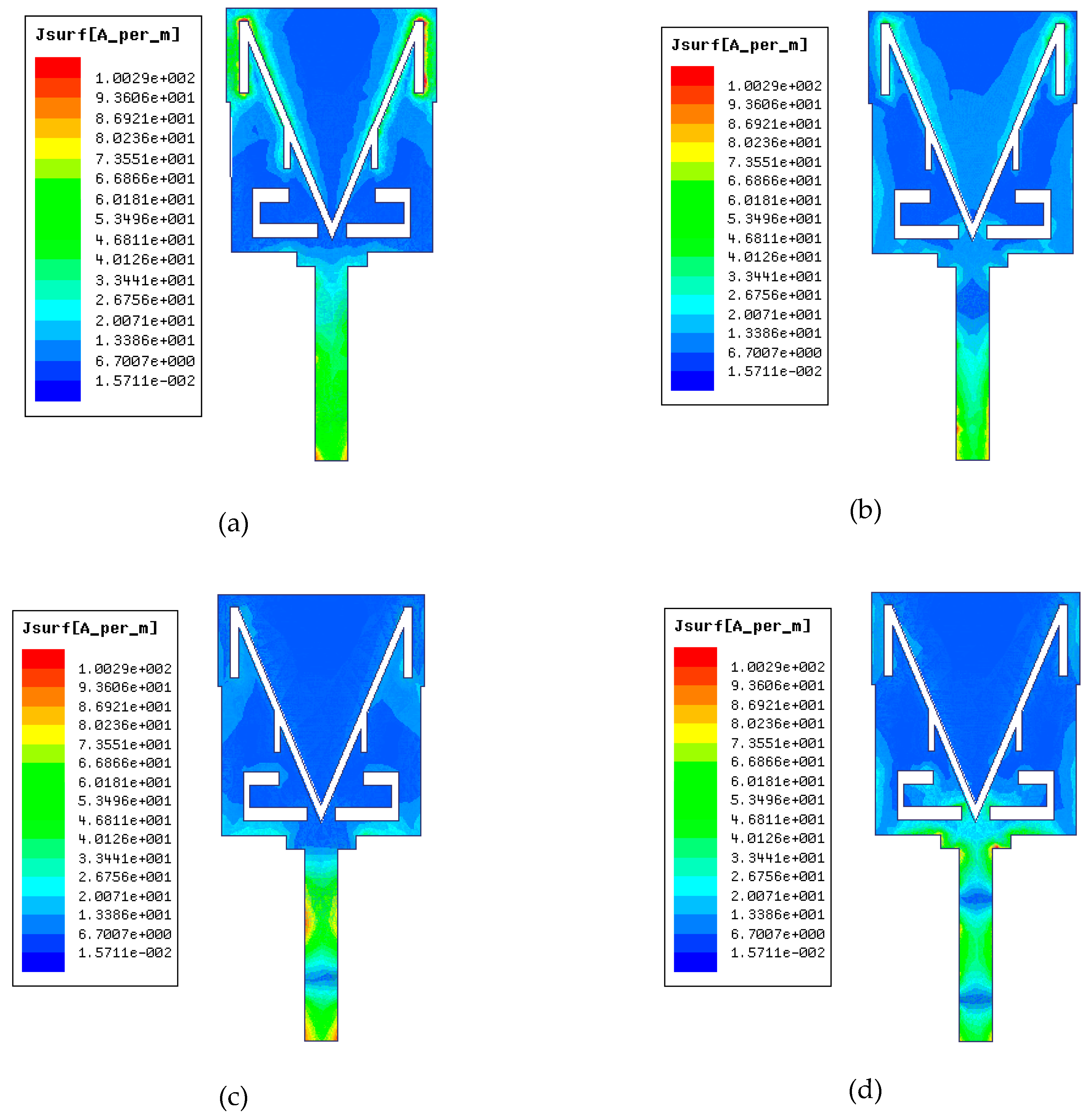
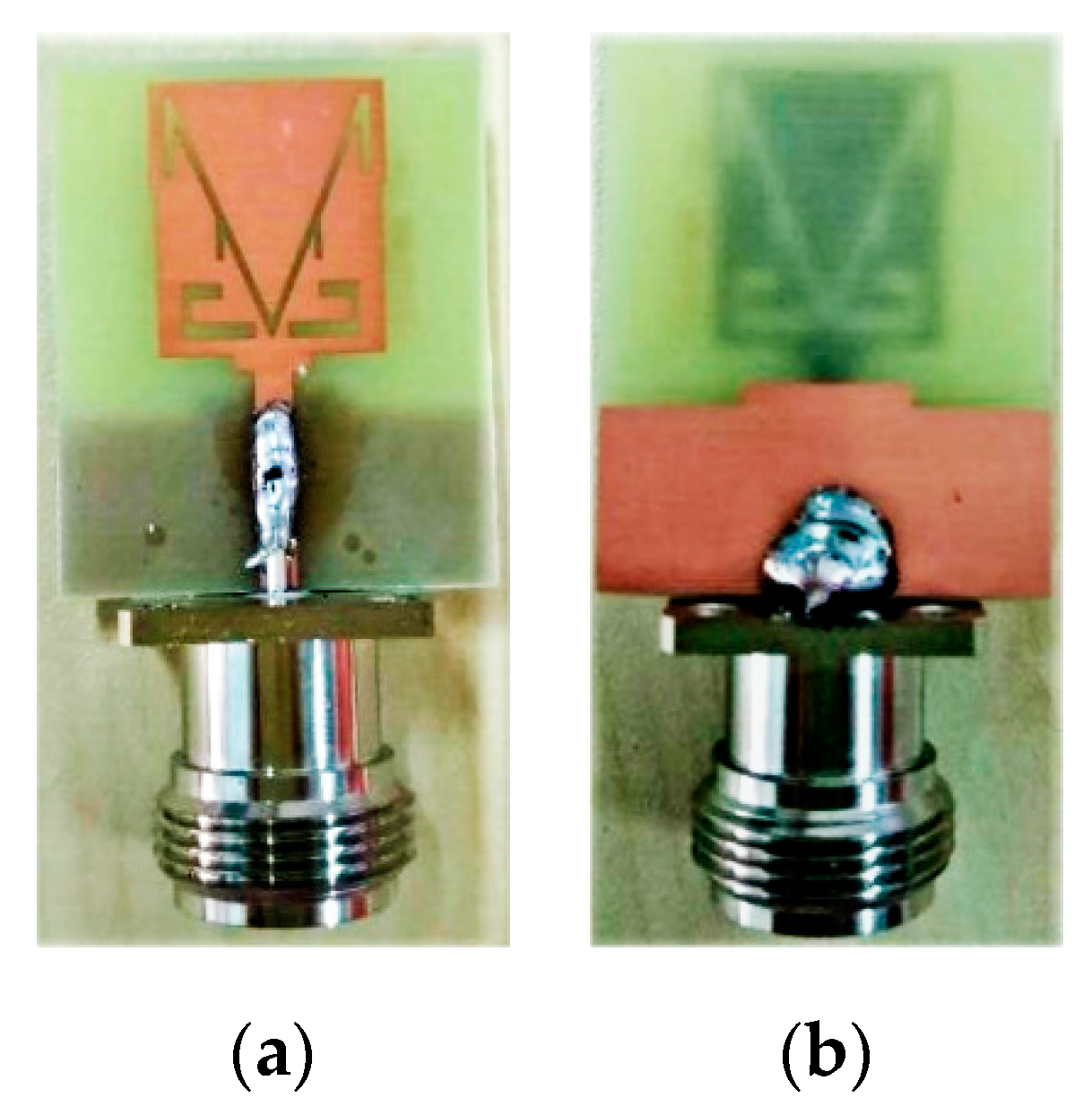
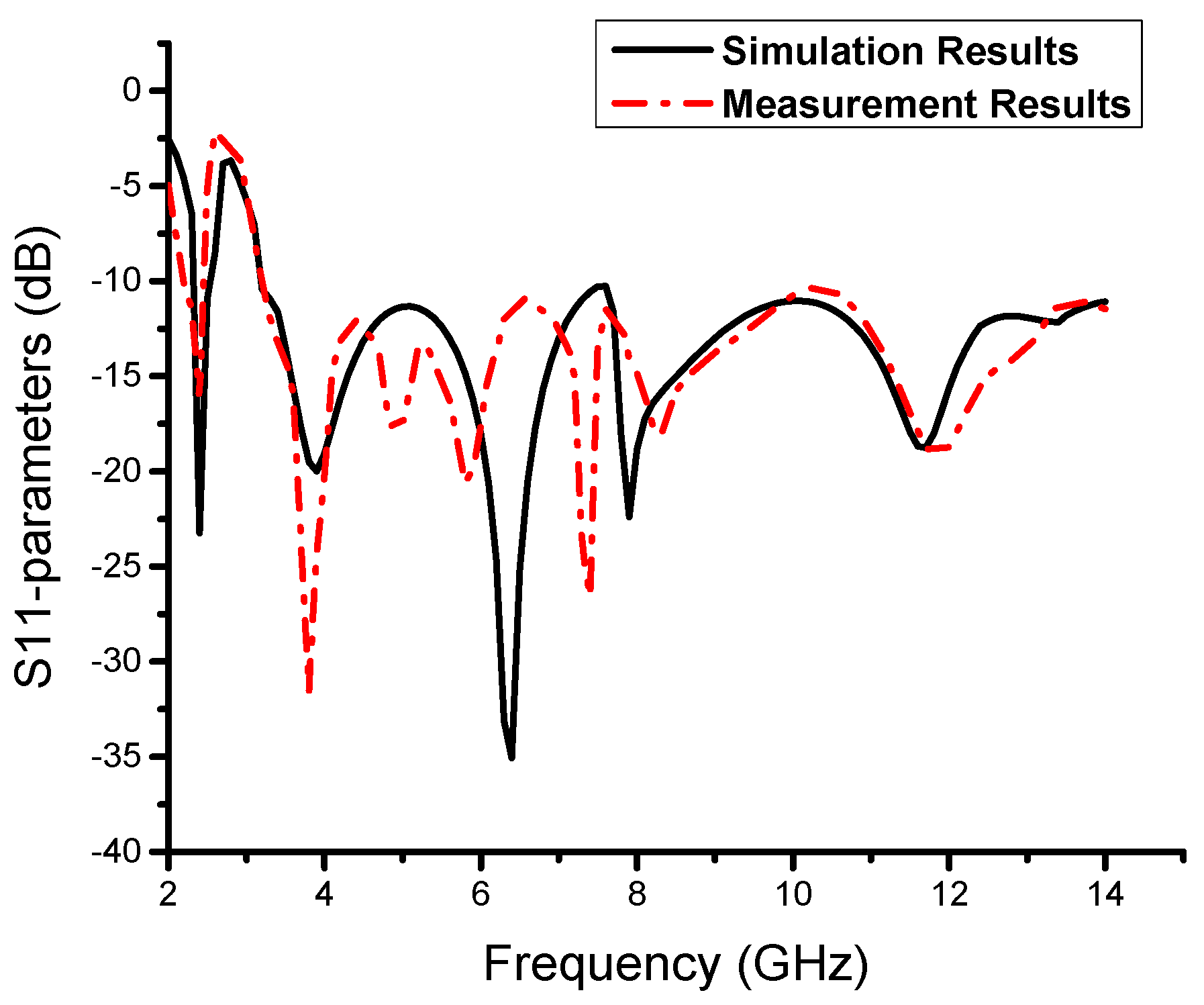

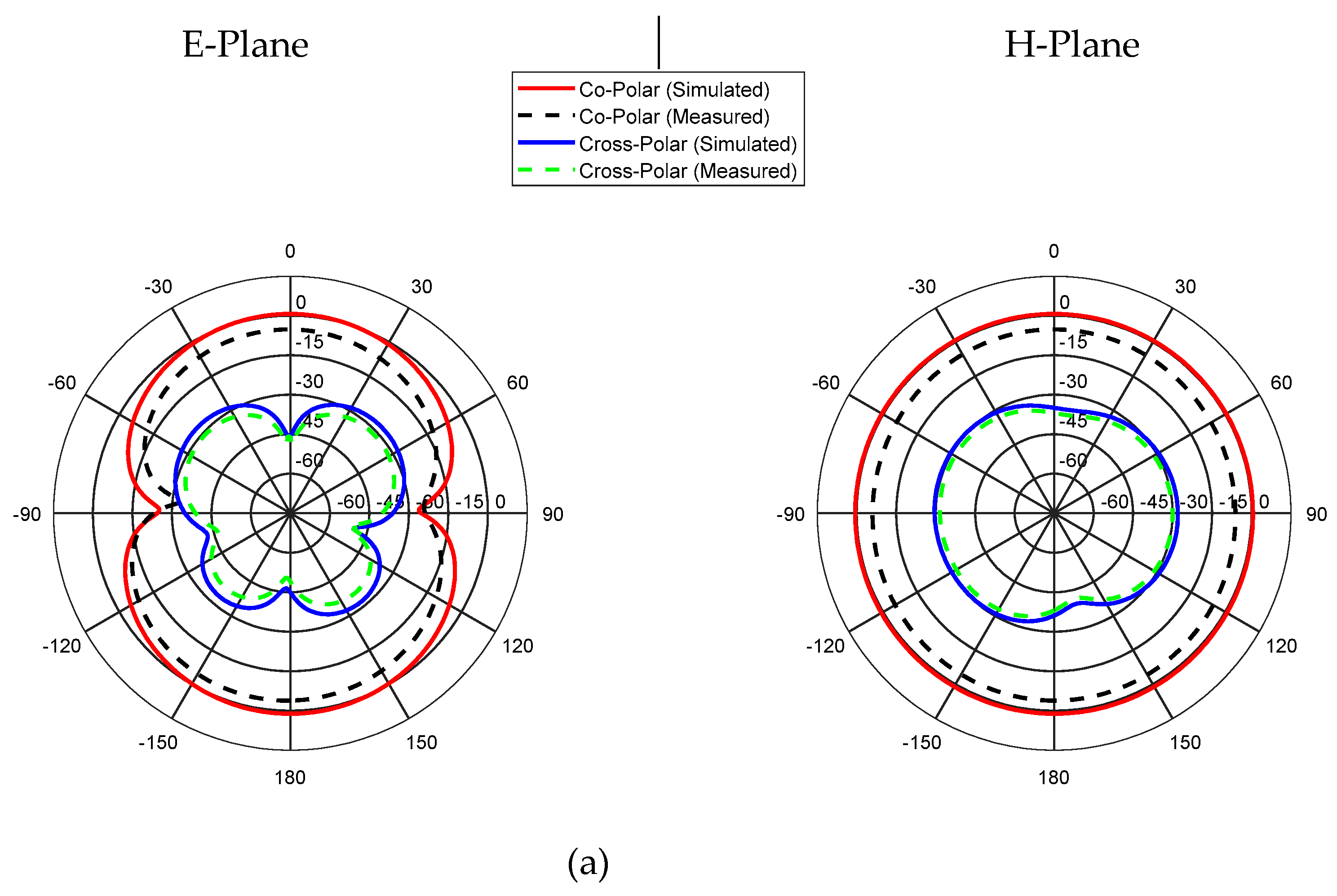

| Parameters | Size (mm) | Parameters | Size (mm) | Parameters | Size (mm) |
|---|---|---|---|---|---|
| LL | 15 | Ly1 | 1.3 | Ly2 | 0.85 |
| Lv1 | 5 | Lv2 | 2.52 | Lv3 | 2.7 |
| Lv4 | 5 | Lx1 | 7 | Lx2 | 3.75 |
| Lx3 | 0.9 | Gv1 | 0.6 | Gv2 | 0.45 |
| Gv3 | 0.5 | α | 46o |
| Reference | Technique | Antenna Size (mm) ( λo = 54 mm) | Antenna peak Gain | Operating band (GHz) | Remarks |
|---|---|---|---|---|---|
| [12] | Octagonal patch with complementary sprit-ring resonator (CSRR) | 25 × 38 × 1.6 (0.46λo × 0.7λo × 0.029λo) | 4.6 dB | 3.2–9.2 | Without narrow band |
| [13] | Octagonal spiral resonator (OSR), Octagonal SRR (OSRR) and CLS resonators | 25 × 25 × 1.6 (0.46λo × 0.46 λo × 0.029λo) | 3.9 dB | 5.2–13.9 | Without narrow band |
| [14] | Rectangular patch | 15 × 30 × 1 (0.27λo × 0.55λo × 0.018λo) | / | 3.1–10 | Without narrow band |
| [15] | Semicircular stepped resonator | 58 × 45 × 1.6 (1.07λo × 0.83λo × 0.018λo) | 10 dB | 3.1–10 | Large antenna size with a long rectangular shape without Wi-Fi band |
| [16] | Meshed top patch & patterned ground plane | 28 × 32 × 0.79 (0.51λo × 0.59λo × 0.014λo) | 5.8 dB | 3.1–12 | Without narrow band |
| [17] | Hexagonal patch with defected ground plane | 20 × 25 × 1.6 (0.37λo × 0.46λo × 0.029λo) | 5.1 dB | 3.09–12.2 | Without narrow band |
| [18] | Cedar tree-shaped | 20 × 20 × 1.6 (0.37λo × 0.37λo × 0.029λo) | 5.5 dB | 3–11.7 | Without narrow band |
| [22] | Resonating monopole strip loaded at the center of the patch | 52 × 32 × 1.59 (0.96λo × 0.59λo × 0.029λo) | 7 dB | 3.1–11.4 & 2.31-2.59 | Large antenna size with long rectangular shape |
| [24] | Loaded with a quarter-wavelength resonating strip | 42 × 24 × 1.6 (0.77λo × 0.44λo × 0.029λo) | 5 dB | 3.1–12 & 2.3–2.5 | Large antenna size with long rectangular shape |
| [26] | Capacitor loaded miniaturized resonator in the ground plane | 30 × 31 × 1.5 (0.55λo × 0.57λo × 0.027λo) | 6dB | 3.1–10.6 & 2.4–2.48 | Complex structure and relatively small operational bandwidth |
| [27] | L-shaped stub | 46 × 42 × 1 (0.58λo × 0.77λo × 0.018λo) | 2.81 dB | 3.1–10.6 & 2.4–2.48 | Large antenna size with long Bluetooth element |
| [28] | Loaded with long Bluetooth strip | 16 × 28 × 1 (0.29λo × 0.51λo × 0.018λo) | 6 dB | 4.5–11 & 2.4–2.48 | Incomplete operational UWB spectrum |
| [29] | Parasitic stub, branch line, and meander line | 19 × 28 × 0.8 (0.35λo × 0.51λo × 0.014λo) | / | 3.1–10.6 & 2.4–2.48 | Complex structure and relatively small operational bandwidth |
| [32] | Loaded with parasitic strip | 46 × 20 × 1 (0.85λo × 0.37λo × 0.018λo) | 4.2 dB | 3.1–10.6 & 2.4–2.48 | Large antenna size with long rectangular shape |
| [33] | Strip-line and cutting ground plate | 45 × 32 × 1 (0.83λo × 0.59λo × 0.018λo) | 3.5 dB | 3.1–10.6 & 2.4–2.5 | Large antenna size with long rectangular shape |
| Proposed antenna | Loaded with V-shaped slot | 27 × 33 × 1.5 (0.5λo × 0.61λo × 0.027λo) | 3.9 dB | 3.2–14 & 2.38–2.57 | simple and compact size with wider operational bandwidth |
© 2019 by the authors. Licensee MDPI, Basel, Switzerland. This article is an open access article distributed under the terms and conditions of the Creative Commons Attribution (CC BY) license (http://creativecommons.org/licenses/by/4.0/).
Share and Cite
Khurshid, A.; Dong, J.; Shi, R. A Metamaterial-Based Compact Planar Monopole Antenna for Wi-Fi and UWB Applications. Sensors 2019, 19, 5426. https://doi.org/10.3390/s19245426
Khurshid A, Dong J, Shi R. A Metamaterial-Based Compact Planar Monopole Antenna for Wi-Fi and UWB Applications. Sensors. 2019; 19(24):5426. https://doi.org/10.3390/s19245426
Chicago/Turabian StyleKhurshid, Adnan, Jian Dong, and Ronghua Shi. 2019. "A Metamaterial-Based Compact Planar Monopole Antenna for Wi-Fi and UWB Applications" Sensors 19, no. 24: 5426. https://doi.org/10.3390/s19245426





